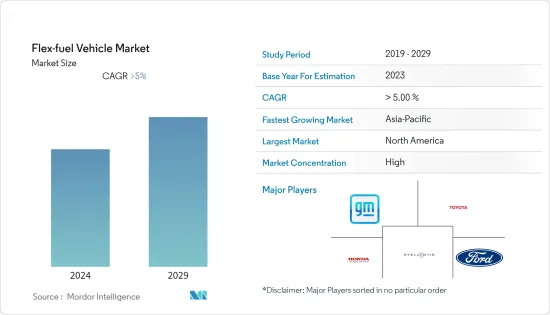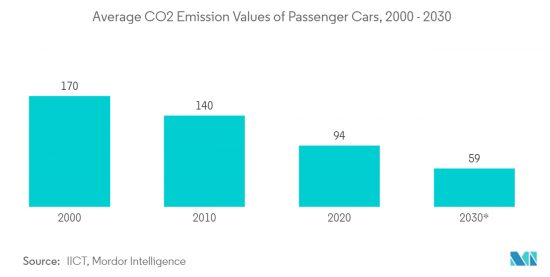
|
市場調査レポート
商品コード
1406909
フレックス燃料車(FFV):市場シェア分析、産業動向・統計、成長予測、2024年~2029年Flex-fuel Vehicle - Market Share Analysis, Industry Trends & Statistics, Growth Forecasts 2024 - 2029 |
||||||
カスタマイズ可能
適宜更新あり
|
|||||||
| フレックス燃料車(FFV):市場シェア分析、産業動向・統計、成長予測、2024年~2029年 |
|
出版日: 2024年01月04日
発行: Mordor Intelligence
ページ情報: 英文 100 Pages
納期: 2~3営業日
|
- 全表示
- 概要
- 目次
フレックス燃料車(FFV)市場は1,040億米ドルと評価され、予測期間中のCAGRは5%を超え、5年間で1,430億米ドルに達すると予測されています。

主なハイライト
- フレックス燃料車(FFV)市場は、他の自動車産業ほど深刻な影響を受けなかった。しかし、市場におけるFFVの選択肢は限られており、各国政府による規制を考慮すると、販売台数は若干減少しました。しかし、状況が緩和し、生活が正常に戻りつつあることから、FFV市場は予測期間中に成長すると予想されます。
- 走行している自動車の大半は従来の化石燃料を燃料としており、有害な排気ガスの増加に繋がっています。自動車公害を抑制するため、複数の県政府がIC(内燃)エンジン搭載車の排ガス規制を打ち出しています。こうした規制により、フレックス燃料で走る自動車の研究の余地が広がっています。
- 市場では、E10からE85以上まで、さまざまなカテゴリーとタイプのFFVがあります。実施されたテストによると、E85燃料で走るFFVは、NOxを23%、COを30%、CO2を4~6%少なくしています。テールパイプ排出量の削減、エタノールベースの燃料の国内生産能力、天然に存在する化石燃料の使用制限など、多くの要因から、FFVの需要は予測期間中に増加すると予想されます。
- フレックス燃料車の需要は米国と中南米地域で大きく伸びています。世界のエタノールの84%以上が米国とブラジルで生産されていると推定されています。
フレックス燃料車市場の動向
厳しい排ガス規制の批准
- 化石燃料を使用するあらゆるタイプの自動車から排出される排ガスが増加し、大気が汚染されています。大気の質の悪化は、深刻な呼吸器疾患の増加につながっています。欧州では、NOx、VOC、PM2.5、PM10などを含む大気汚染全体の30%以上が自動車によるものです。
- 排ガスを規制するため、各国の自動車当局は、自動車のテールパイプからNOx、SOxなどの温室効果ガスやその他の有害汚染物質が発生するのを禁止しています。
- 例えば欧州では、排ガス規制が年々厳しくなっています。規制当局である欧州環境庁(EEA)によると、2005年に開始されたEuro4では、0.08g/kmであったNOx基準は、2009年には0.06g/kmに引き下げられ、それ以降、軽乗用車のNOx基準は変わっていません。
- 同様に、2015年のCO2排出量については、普通乗用車は130g/kmを超えることは許されませんでしたが、2020年には95g/kmに改定されました。また、欧州委員会は2025年までにこの数値を70g/kmまで引き下げることを目標としています。
- 排気ガスからの温室効果ガスが減ることは、長期的には健康に大きな影響を与えると思われます。また、フレックス燃料は従来のガソリンやディーゼルに比べてクリーンな燃料であるため、フレックス燃料市場は今後数年間で需要が増加することが予想されます。

アジア太平洋が著しい成長を遂げる
- 現在、アジア太平洋地域の70%以上の国が、自動車を走らせるために化石燃料の輸入に頼っています。原油コストとその精製コストは、消費者の燃料コストを大幅に上昇させる。インドや中国のような新興市場により、アジア太平洋地域は大きな成長が見込まれています。
- 例えばインドでは、化石燃料の消費を抑制し燃料コストを引き下げるため、MoRTH(道路交通・高速道路省)がエタノールベースの燃料を国内に導入するためのさまざまな期限を打ち出しています。また、インドは世界のフレックス燃料生産量の2%を占めているが、これは国の要求を満たすには不十分です。そのため、エタノールの国内生産量は今後数年間で7,000万リットルから1億5,000万リットルに増加することが目標とされています。
- 運輸省は、段階的にエタノールベースの燃料の使用を拡大する計画です。E10は2022年4月から、E20は2025年から生産が開始される予定です。国内の各自動車メーカーも、2023年4月からE10、2025年4月からE20で自動車を走らせるための調査を拡大するよう通達されています。
- フレックス燃料はサトウキビなどの再生可能原料を使って国内で製造できるため、エタノール混合燃料は原燃料の輸入量を減らし、エンドユーザーの燃料費削減に貢献します。
- エタノールベースのフレックス燃料の利用可能性が高まるにつれ、インドは世界で2番目に人口の多い国であるため、フレックス燃料車の需要が大きく伸びる可能性があります。
フレックス燃料車産業の概要
フレックス燃料車市場は様々な企業によって構成され、統合された市場を形成しています。フレックス燃料で走る幅広い製品と代替燃料を見つけるための絶え間ない開拓により、市場の主要企業5社が大きな市場シェアを占めています。例えば、ゼネラル・モーターズは約13車種、フォード・モーターは11車種、Stallintis NVは7車種をエタノール混合燃料で走らせています。
上位5社には、ゼネラルモーターズ、フォード・モーター、トヨタ自動車、ステランティスNV、本田技研工業、現代自動車が含まれます。その他のプレーヤーには、日産自動車、SUBARU CORPORATION、Volkswagen AGが含まれます。
その他の特典:
- エクセル形式の市場予測(ME)シート
- 3ヶ月間のアナリストサポート
目次
第1章 イントロダクション
- 調査の前提条件
- 調査範囲
第2章 調査手法
第3章 エグゼクティブサマリー
第4章 市場力学
- 市場促進要因
- 厳しい排ガス規制の批准
- 市場抑制要因
- 電気自動車販売の増加が市場成長の抑制要因になる可能性
- ポーターのファイブフォース分析
- 供給企業の交渉力
- 消費者の交渉力
- 新規参入業者の脅威
- 代替品の脅威
- 競争企業間の敵対関係の強さ
第5章 市場セグメンテーション
- エタノール混合タイプ
- E10~E25
- E25~E85
- E85以上
- 車両タイプ
- 乗用車
- 商用車
- 燃料タイプ
- ガソリン
- ディーゼル
- 地域
- 北米
- 米国
- カナダ
- その他北米
- 欧州
- ドイツ
- フランス
- スペイン
- 英国
- その他欧州
- アジア太平洋
- 中国
- インド
- 韓国
- 日本
- その他アジア太平洋
- 世界のその他の地域
- 南米
- 中東・アフリカ
- 北米
第6章 競合情勢
- ベンダー市場シェア
- 企業プロファイル
- General Motors
- Toyota Motor Corporation
- Honda Motor Company
- Stellantis NV
- Ford Motor Company
- Hyundai Motor Company
- Nissan Motor Company
- Subaru Corporation
- Volkswagen AG
- BMW AG
- Volvo Car Corporation
第7章 市場機会と今後の動向

The solid-state battery market was valued at USD 104 billion, and it is expected to reach USD 143 billion over the period of five years, registering a CAGR of over 5% during the forecast period.
Key Highlights
- The market for flex-fuel vehicles (FFV) was not impacted by the COVID-19 pandemic as severely as other automotive industries. However, with limited options for an FFV in the market, it did witness a slight decline in sales, considering the restrictions imposed by the respective governments. However, with the situation easing and life returning to normalcy, the FFV market is anticipated to grow during the projected period.
- Most of the vehicles running are fueled using conventional fossil fuels, which has led to an increase in toxic exhaust gas emissions. To control vehicular pollution, multiple county governments have put forth several emission restrictions for IC (internal combustion) engine-powered vehicles. These restrictions have opened the scope for research on vehicles running on flex fuels.
- In the market, there are various categories and types of FFV from E10 to E85 and above. According to the tests conducted, FFVs running on E85 fuel produce 23% less NOx, 30% less CO, and 4-6% lower CO2. Due to numerous factors, including reduced tailpipe emissions, domestic production capabilities of ethanol-based fuels, and limiting the use of naturally occurring fossil fuels, the demand for FFVs is expected to increase during the forecast period.
- The demand for flex-fuel vehicles is growing significantly in the United States and the Latin American region. It is estimated that more than 84% of the world's ethanol is produced by the United States and Brazil.
Flex-fuel Vehicle Market Trends
Ratification of Stringent Exhaust Emission Regulations
- The increase in vehicle exhaust emissions from all types of vehicles using fossil fuels has contaminated the atmosphere. The poor air quality has led to an increase in a plethora of serious respiratory diseases. In Europe, vehicular pollution contributes to over 30% of total air pollution, including NOx, VOCs, PM2.5, PM10, and others.
- To bring exhaust emissions under control, country-specific vehicle authorities have barricaded the production of greenhouse gasses like NOx, SOx, and other harmful pollutants from vehicle tailpipes.
- For instance, in Europe, exhaust emission norms have become even more strict over the years. According to the regulatory authority European Environmental Agency (EEA), in Euro 4, launched in 2005, the NOx standards were affixed at 0.08g/km, whereas in 2009, it got reduced to 0.06g/km, and it has remained the same for light passenger cars since.
- Similarly, for CO2 emissions in 2015, standard passenger cars were not allowed to exceed 130g/km of CO2. In 2020, it was revised to 95g/km. The European Commission also targets to reduce this number to 70g/km by 2025.
- The reduced amount of greenhouse gases from the exhaust will have a significant impact on health in the long run. Alongside, this will also allow the flex-fuel market to witness an increase in demand in the upcoming years as it is a clean-burning fuel as compared to conventional gasoline or diesel.

Asia-Pacific to Witness Significant Growth
- More than 70% of the countries in the Asia-Pacific region currently rely upon the import of fossil fuels to run vehicles. The cost of crude oil and its refinement significantly increases the consumer cost of fuel. With emerging markets like India and China, the Asia-Pacific region is expected to witness significant growth.
- For instance, in India, to curb the consumption of fossil fuels and tone down fuel costs, MoRTH (Ministry of Road Transport and Highways) has put forward various deadlines to introduce ethanol-based fuel in the country. Additionally, India accounts for 2% of the global flex-fuel production, which is not enough to fulfill the country's requirements. Hence, the domestic production of ethanol is targeted to rise from 70 to 150 million liters in the next few years.
- The transport ministry is planning to roll out the use of ethanol-based fuel in phases. E10 production is expected to be in motion from April 2022 and E20 from 2025. Various vehicle manufacturers in the country have also been notified to scale up the research to run vehicles on E10 from April 2023 and E20 from April 2025.
- As flex fuels can be manufactured domestically using renewable materials like sugar cane, the ethanol-blended fuel will reduce the quantity of raw fuel imported, helping reduce the fuel cost for end users.
- With the increase in the availability of ethanol-based flex-fuel, the demand for flex-fuel vehicles may witness significant growth as India is the world's second-most populated country.
Flex-fuel Vehicle Industry Overview
The flex-fuel vehicle market constitutes various players accounting for a consolidated market. Owing to a wide range of products running on flex fuels and constant developments to find an alternative fuel, the top five players in the market account for a significant market share. For instance, General Motors has about 13 vehicle models, Ford Motor Co. has 11 vehicle models, and Stallintis NV has seven vehicle models running on ethanol blend fuel.
The top five players include General Motors, Ford Motor Co., Toyota Motor Corp., Stellantis NV, Honda Motor Co., and Hyundai Motor Co. Other players include Nissan Motor Company, Subaru Corporation, and Volkswagen AG.
Additional Benefits:
- The market estimate (ME) sheet in Excel format
- 3 months of analyst support
TABLE OF CONTENTS
1 INTRODUCTION
- 1.1 Study Assumptions
- 1.2 Scope of the Study
2 RESEARCH METHODOLOGY
3 EXECUTIVE SUMMARY
4 MARKET DYNAMICS
- 4.1 Market Drivers
- 4.1.1 Ratification of Stringent Exhaust Emission Regulations
- 4.2 Market Restraints
- 4.2.1 Increase Sales of Electric Vehicle May Restraint the Growth of the Market
- 4.3 Porter's Five Forces Analysis
- 4.3.1 Bargaining Power of Suppliers
- 4.3.2 Bargaining Power of Consumers
- 4.3.3 Threat of New Entrants
- 4.3.4 Threat of Substitute Products and Services
- 4.3.5 Intensity of Competitive Rivalry
5 MARKET SEGMENTATION
- 5.1 Ethanol Blend Type
- 5.1.1 E10 to E25
- 5.1.2 E25 to E85
- 5.1.3 E85 and Above
- 5.2 Vehicle Type
- 5.2.1 Passenger Cars
- 5.2.2 Commercial Vehicles
- 5.3 Fuel Type
- 5.3.1 Petrol
- 5.3.2 Diesel
- 5.4 Geography
- 5.4.1 North America
- 5.4.1.1 United States
- 5.4.1.2 Canada
- 5.4.1.3 Rest of North America
- 5.4.2 Europe
- 5.4.2.1 Germany
- 5.4.2.2 France
- 5.4.2.3 Spain
- 5.4.2.4 United Kingdom
- 5.4.2.5 Rest of Europe
- 5.4.3 Asia-Pacific
- 5.4.3.1 China
- 5.4.3.2 India
- 5.4.3.3 South Korea
- 5.4.3.4 Japan
- 5.4.3.5 Rest of Asia-Pacific
- 5.4.4 Rest of the World
- 5.4.4.1 South America
- 5.4.4.2 Middle East and Africa
- 5.4.1 North America
6 COMPETITIVE LANDSCAPE
- 6.1 Vendor Market Share
- 6.2 Company Profiles
- 6.2.1 General Motors
- 6.2.2 Toyota Motor Corporation
- 6.2.3 Honda Motor Company
- 6.2.4 Stellantis NV
- 6.2.5 Ford Motor Company
- 6.2.6 Hyundai Motor Company
- 6.2.7 Nissan Motor Company
- 6.2.8 Subaru Corporation
- 6.2.9 Volkswagen AG
- 6.2.10 BMW AG
- 6.2.11 Volvo Car Corporation

